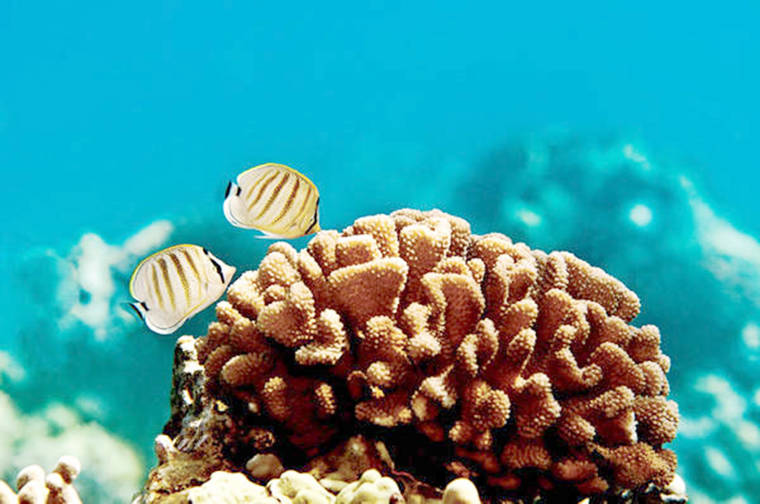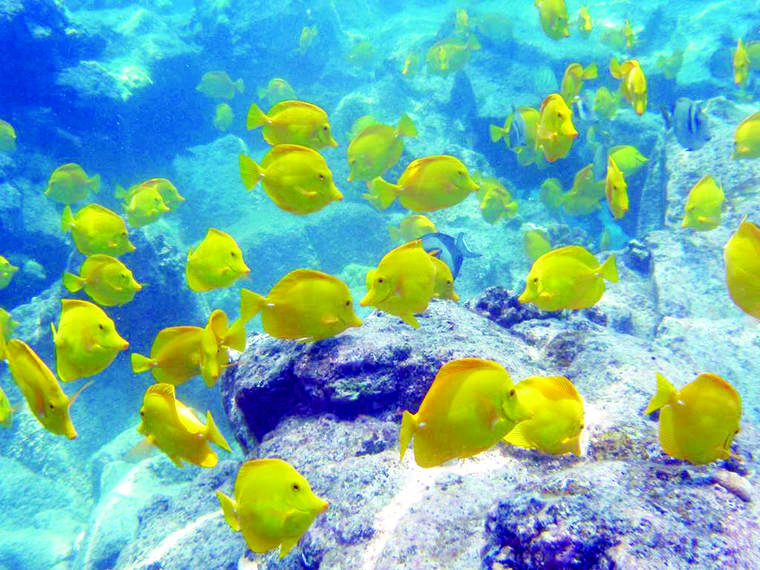Court ruling closes loophole for commercial aquarium collection

These multi-band butterfly fish live on reefs and are a species collected by the aquarium trade. (Contributed file photo by Robert Winter/Special to West Hawaii Today)

This undated file photo from Oregon State University shows a school of yellow tang off the coast of Hawaii Island. The state says it is taking immediate steps to comply with a court order shutting a loophole that allowed for continued commercial aquarium fish collection despite a 2017 high court ruling that halted the practice pending environmental review. (AP Photo/Oregon State University, Bill Walsh,File)
The state says it is taking immediate steps to comply with a court order shutting a loophole that allowed for continued commercial aquarium fish collection despite a 2017 high court ruling that halted the practice pending environmental review.
The state says it is taking immediate steps to comply with a court order shutting a loophole that allowed for continued commercial aquarium fish collection despite a 2017 high court ruling that halted the practice pending environmental review.
The Department of Land and Natural Resources Division of Aquatic Resources said Monday afternoon it will cease renewal and issuance of new commercial marine licenses under Hawaii Revised Statues 189-2 without a condition prohibiting the take of marine life for aquarium fishing purposes until Chapter 343 environmental review ordered by the Hawaii Supreme Court is complete.
The 41 current CML holders that report aquarium fish catch will retain their licences, the state said in the prepared statement. Those licenses, which are issued for one-year periods, will remain valid because the court declined without prejudice to issue an injunction immediately stopping the practice.
The move follows an order out of the First Circuit handed down Friday by Environmental Court Judge Jeffrey P. Crabtree ruling the DLNR violated the Hawaii Environmental Policy Act for failing to complete the required environmental review process, making issuing and renewing CMLs pursuant to HRS 189-2 “invalid and illegal.”
“The court gave a lot of thought to this motion, and did not reach its conclusions lightly. The court knows that the declarations submitted that this ruling will cause economic hardship to aquarium fishers, their families, employees, and vendors. That is truly unfortunate, especially during the hardships already occurring from the pandemic,” Crabtree opined. “But respectfully, the court is convinced that the rule of law requires an environmental assessment under the clear facts of this case.”
Willie Kaupiko, Kaimi Kaupiko, Mike Nakachi, For the Fishes, and the Center for Biological Diversity, represented by Earthjustice, filed the lawsuit in January to “enforce the letter and intent of the courts’ prior rulings and ensure that all aquarium collection complies with the environmental review process required under the Hawaii Environmental Policy Act” (HEPA).
On Sept. 6, 2017, the Hawaii Supreme Court ruled the issuance of commercial aquarium collection permits under HRS 188-31 required HEPA review. The next month, the court invalidated all unexpired commercial aquarium permits and prohibited the state from issuing or renewing any commercial aquarium collection permits until the review was completed.
The lawsuit filed earlier this year alleged the DLNR, however, allowed commercial aquarium collection to continue despite the court’s order, issuing or renewing at least 72 commercial marine licenses to commercial aquarium collectors under HRS 189-2.
“Since the Umberger opinion and subsequent circuit court orders, DLNR has abruptly reversed its decades-old practice of requiring both a 189-2 CML and a 188-31 aquarium permit for commercial aquarium collection and, instead, has allowed such extraction to continue under CMLs alone, based on newfound and invalid legal interpretation that such collection does not require an aquarium permit or HEPA review so long as it occurs without the use of fine-meshed gear.”
Between October 2017 and October 2019, the plaintiffs said the state logged commercial take of at least 576,741 specimens (372,769 fish and 203,972 invertebrates) for aquarium purposes. In 2011, according to the lawsuit, 721,177 specimens were taken and in 2012, 766,650 were collected.
An environmental assessment rejected earlier this year found the Hawaii commercial aquarium fishery reported landings greater than $2.2 million in 2017. Hawaii Island reported landings near $1.4 million with more than $1.29 million in the West Hawaii Regional Fishery Management Area (WHRFMA) alone.
The WHRFMA, which spans from Upolu Point in North Kohala to Ka Lae (South Point) in Ka‘u, was the only area the state did not issue the commercial marine licenses to commercial aquarium collectors, the lawsuit alleged, noting the specific regulations outlined for the area.
To date, no environmental review for commercial taking of aquarium fish has been completed and accepted.
The most recent attempt, the submission of an environmental assessment by 10 aquarium fishers inside the WHRFMA and amicus participant National Pet Industry Joint Advisory Council, was rejected by 7-0 the state Board of Land and Natural Resources. The decision was upheld by the state Environmental Council in August, leaving intact the moratorium on commercial aquarium collection along West Hawaii coast.
In a prepared statement, the plaintiffs said Friday’s “victory in court will stop the reckless collection of marine animals that threaten to empty Hawaii reefs.”
“We are relieved that the court shut this illegal loophole so our reefs can finally rest while the agency examines the industry’s harmful effects. These reefs are vital to our way of life and to the health of our entire Pae‘aina (Hawaiian Islands),” said Milolii resident Kaimi Kaupiko, who regularly fishes with his family in waters off the traditional Hawaiian fishing village.
Earthjustice attorney Mahesh Cleveland said the ruling confirms “what should have been clear in the first place.”
“Resorting to new techniques won’t get you off the hook. If you want to take fish from our waters to profit from the trade, you need to examine and disclose the environmental impacts first. Anything less would be an injustice to people that rely on healthy and diverse reef ecosystems today, and even more so to our future generations,” Cleveland said.


